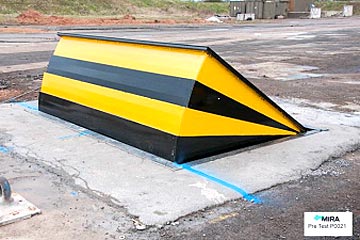See This Report about Wedge Barriers


18 may be done faster, conveniently, and expense successfully. FIG. In certain personifications, the anchor 30 may be a steel framework including plates, beam of lights(e. g., I-beams ), and/or other frameworks that are protected within the structure 14, which may be concrete. At the surface area 12, an upper side 28 of the support 30 may be at the very least partially subjected
, thus making it possible for the add-on of the barrier 10 to the anchor 30. g., threaded holes)in one or even more beams or plates of the support 30 might be revealed to the surface area 12. In this fashion, bolts 32 or other mechanical bolts may be made use of to secure the barrier 10 to the support 30. As the barrier 10 is placed to the surface 12 of the structure 14, collection of debris and various other product underneath the barrier might be minimized, and components of the bather 10 may not be exposed to listed below quality settings. As shown by reference numeral 52, the lifting device 50 consists of elements disposed beneath the wedge plate 16. The elements 52 underneath the wedge plate 16 may consist of an electromechanical actuator, a cam, one or more webcam surface areas, and so forth. Additionally, the lifting mechanism 50 consists of a spring assembly 54
The spring rod 58 is combined to a camera(e. g., cam 80 shown in FIG. 4) of the lifting system 50. The springs 60 disposed regarding the spring pole 58 are kept in compression by springtime sustains 62, consisting of a repaired springtime support 64. That is, the fixed spring support 64 is repaired about the structure 14 et cetera of the bather 10.
All About Wedge Barriers
g., springtime support 65 )might be taken care of to the end of the spring pole 58 to allow compression of the springs 60. As the springs 60 are compressed between the springtime supports 62, the springtime assembly 54 creates a force acting upon the web cam coupled to the springtime rod 58 in an instructions 66. The remaining pressure used to
the cam web cam deploy the wedge plate 16 may might provided offered an electromechanical actuator 84 or other various other. The springtime setting up 54 and the actuator 84(e. g., electromechanical actuator)may operate with each other to convert the webcam and raise the wedge plate 16.
As pointed out over, the spring assembly 54 exerts a constant force on the cam, while the electromechanical actuator may be controlled to apply a variable pressure on the web cam, thus allowing the training and reducing( i. e., releasing and retracting )of the wedge plate 16. In particular embodiments, the consistent pressure used by the spring assembly 54 may be adjustable. g., electromechanical actuator) is impaired. As will certainly be valued, the spring assembly 54 might be covered and protected from debris or other elements by a cover plate(e. g., cover plate 68 shown in FIG. 4) that may be considerably flush with the elevated surface 38 of the foundation 14. As mentioned above, in the deployed placement, the wedge plate 16 offers to obstruct access or traveling beyond the barrier 10. The barrier 10(e. g., the wedge plate 16 )may block pedestrians or vehicles from accessing a residential or commercial property or path. As gone over over, the barrier 10 is affixed to the anchor 30 safeguarded within the structure 14,

front brackets 71. Consequently, the linkage settings up 72 may pivot and turn to make it possible for the collapse and expansion of the linkage assemblies 72 during retraction and deployment of the bather 10. The link assemblies 72 reason activity of the wedge plate 16 to be limited. If a vehicle is taking a trip in the direction of the released wedge plate 16(e. For instance, in one circumstance, the safety legs 86 may be extended duringmaintenance of the barrier 10. When the security legs 86 are deployed, the security legs 86 support the weight of the wedge plate 16 against the surface 12. As a result, the lifting system 50 may be shut down, serviced, removed, changed, etc. FIG. 5 is partial viewpoint view of an embodiment of the surface-mounted wedge-style barrier 10, highlighting the cam 80 and the web cam surfaces 82 of the lifting mechanism 50. Particularly, two webcam surfaces 82, which are referred to as lower cam surface areas 83, are placed below the webcam 80. The lower webcam surfaces 83 might see here be dealt with to the surface area 12 (e. For instance, the lower webcam surfaces 83 and the mounting plate 85 might develop a single item that is secured to the support 30 by screws or other mechanical fasteners. Additionally, 2 web cam surface areas 82, which are referred to as top camera surfaces 87, are positioned above the web cam 80 and coupled to (e. In other embodiments, interfering layers or plates may be positioned between the surface area 12 and the lower cam surface areas 83 and/or the wedge plate 16 and the upper web cam surfaces 87 As pointed out above, the web cam
80 equates along the cam surface areas 82 when the wedge plate 16 is lifted from the withdrawed setting to the deployed setting. Additionally, as stated above, the spring setting up 54 (see FIG. 3 )may give a force acting on the camera 80 in the direction 102 using spring pole 58, which may minimize the force the electromechanical actuator 84 is needed to put on the camera 80 in order to actuate and lift the wedge plate 16. 1 )to the released position(see FIG. 4). As revealed, the camera 80 consists of track wheels 104(e. g., rollers), which get in touch with Get More Information and convert along the webcam surface areas 82 throughout operation.